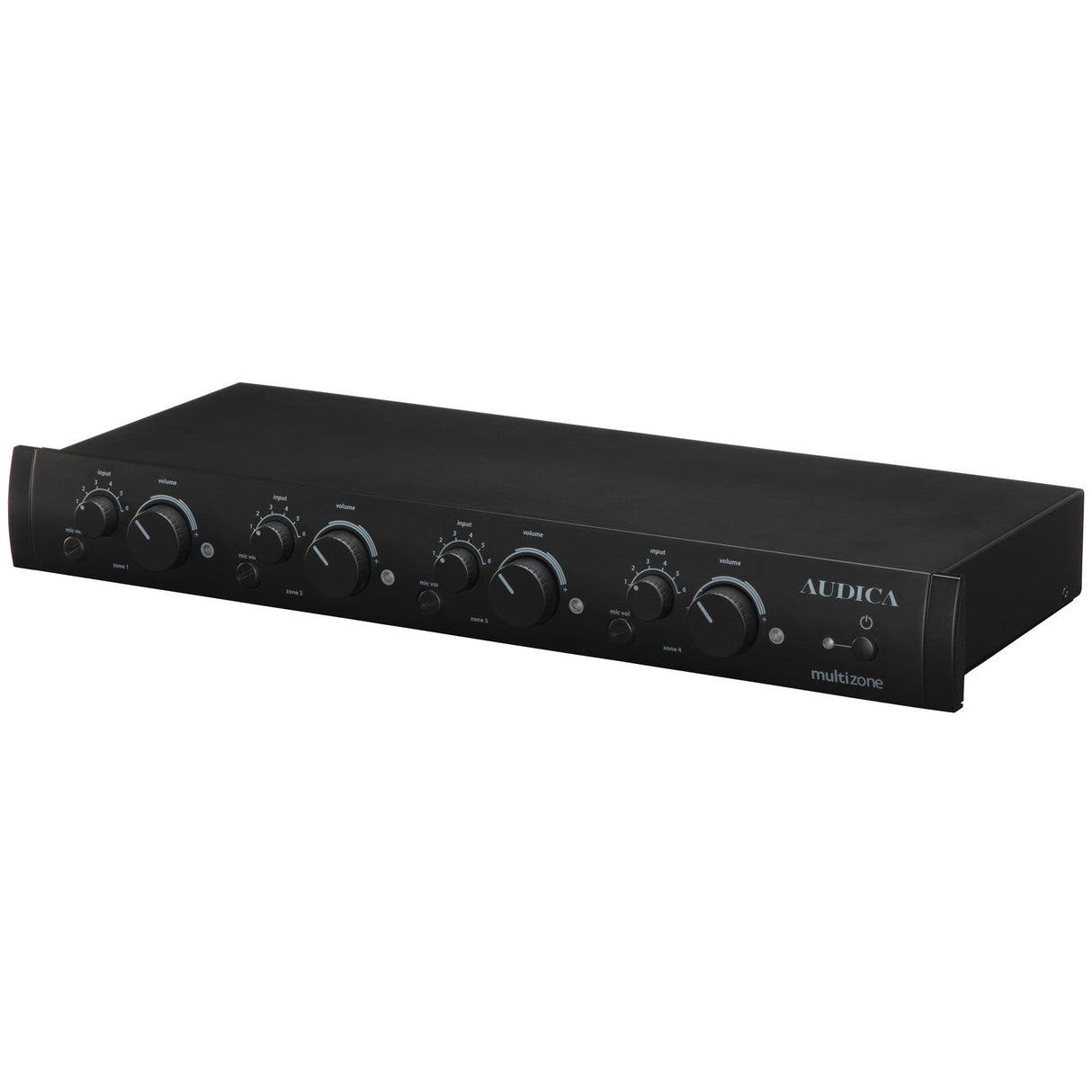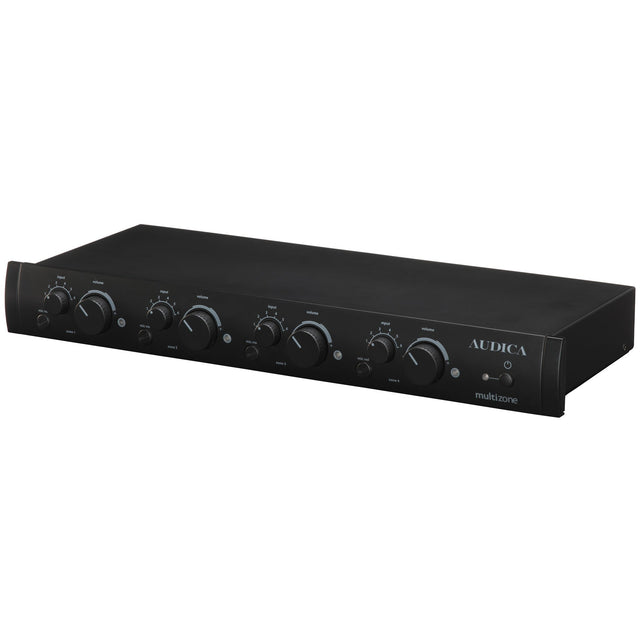Free Shipping
More finance options:
Estimated Shipping Widget will be displayed here!
Condition: New
Audica MULTIzone 4-Channel System Controller
A zone control mixer consisting of 4 zones with 6 music inputs plus a microphone input for paging applications. Each of the 4 outputs can be independently configured to provide music from any one of the inputs plus the paging microphone and the relative levels are set by front panel controls. The music is automatically reduced in level (ducking) to allow for announcements to be heard clearly. Each zone output is mono and all inputs are stereo capable (mixed to mono internally).
Zone outputs can have flat response or Audica loudspeaker EQ, as required. A mute control input is provided to be linked to fire control systems. This mutes all music inputs whilst keeping the paging microphone active for safety announcements. Remote zone control is possible via wired control panels or an RS232 interface. Up to 7 MULTIzone units can be linked (daisy-chained) for systems of up to 28 zones.
Each of the 4 zones has independent controls for all variables. A rotary switch selects which input is used for that zone and the level of the music is set by a rotary control, both on the front panel. The mix of the microphone into the zone is controlled by a separate “preset” style rotary control, adjustable via a screwdriver on the front panel. When the microphone signal exceeds a threshold the music level is reduced automatically to a level which allows the microphone signal to be clearly heard (This attenuation is adjustable on the rear panel).
Each input has independent gain control to allow matching of source levels, preventing level jumps when selecting a different music source and optimizing the signal to noise ratio of the system. The microphone input also has a gain control to match a variety of microphones to the required optimum input level. Since the gain range on the Mic input is +50dB to -10dB this can also be used as a line level input (maximum input 3.3Vrms).
Some buildings require that the music system is muted if the fire alarm is triggered. Two types of input are provided on the unit for this purpose. A set of isolated contacts can be wired in (e.g., a relay activated by the fire control panel) or a voltage input can be accepted (3-24V DC). In either case the “polarity” or logic sense of the input can be reversed using an internal jumper if required. As shipped the contact input is Normally Open (NO) and the voltage input will mute when a voltage of 3-24V is applied.
The RS232 control port allows all the main user interface features to be controlled from a PC/Crestron/AMX etc. Output channels can be independently switched to RS232 control whilst leaving others working from their front panel controls or remote keypads; this gives great flexibility in system configuration.
Technical Specifications
Inputs
Stereo Phono jack pair for input 1, 2, 3, 4, 5, 6
XLR balanced input for paging microphone. (48V Phantom power option provided)
15-pin D-Type connector for looping the audio (and optionally Mic and RS232) inputs to another unit.
There are also five control inputs: Remote zone control on RJ45 connector for zone 1, 2, 3, 4 and RS232
Other
AC supply on IEC 3-pin socket. 2-meter mains cable according to sku.
MUTE input for fire control panel on Phoenix connectors. This can be wired for isolated contacts (Normally Open) or a voltage input (3-24V DC). The sense of this input can be reversed by an internal jumper such that a Normally Closed contact or absence of the 3-24V causes muting instead.
Outputs
Eight outputs are available and a loop-through is provided for daisy chaining inputs to multiple units.
Mono phono jack output for zone 1, 2, 3, 4. Selectable flat or AEQ curve.
Balanced audio output on Phoenix connector for zone 1, 2, 3, 4. Replicates phono jack output for zone.
15-pin D-Type connector for looping the audio inputs (and optionally Mic and RS232) to another unit.
Controls
Front panel
Mains power switch (full AC line switch - not a standby control)
zone 1, 2, 3, 4 source selector. zone 1, 2, 3, 4 music level control.
zone 1, 2, 3, 4-page mic mixing level. (When set to zero music ducking is disabled for that channel)
Rear panel
Rotary potentiometer to set gain for input 1, 2, 3, 4, 5, 6. Rotary potentiometer to set gain of Microphone input.
DIP switch to enable 48V phantom power for Microphone input.
Rotary potentiometer to set compressor contribution to mic channel.
Rotary potentiometer for low-mid tone control on Microphone input (Centered at 150Hz).
Rotary potentiometer for mid-high tone control on Microphone input (Centered at 5kHz).
Rotary potentiometer for music ducking “floor level” (music attenuation level).
Rotary potentiometer for music ducking release time (music fade-up time).
DIP switch to set the MIC source (input or loop-through).
Three DIP switches for RS232 address setting (1 to 8).
DIP switch for RS232 source switch (input or loop-through).
Four DIP switches to enable Audica speaker EQ (AEQ) on each output channel.
Front panel Indicators
Power LED. Off when Mains power switch is off. Blue when mains power is on. Short-term rapid flashing indicates RS-232 enabled standby mode in operation.
Channel indicators. Each channel has a white indicator LED to show signal present. The brightness of the LED gives some indication of signal level.
Rear panel Indicators
MIC LED. This is a 2-colour LED to assist in MIC input level setting. Green indicates signal is in the optimum range (>-20dB) and Red indicates clipping imminent (>-2dB)
Input channels. A single 2-colour LED is provided to set the line input levels. By applying a signal on each input in turn the level can be set as per the MIC LED above.
RS-232 Interface
The RS-232 interface allows control of all basic functions of the unit. Commands are provided for “absolute” control (e.g., Volume = 68) only. It also controls which channels are assigned to RS232. This allows some channels to remain under manual control whilst others are RS-232 controlled. The user can also set an address for the MULTIzone on its rear panel allowing multiple chained units to be controlled from one RS-232 port. If this feature is required then the user simply sets the RS-232 source to “Chain” on the rear panel and assigns different addresses to each unit. The RS-232 data is relayed to all chained units using the same cable as the signal loop-through. The RS-232 port is uni-directional, the MULTIzone does not send any data.








